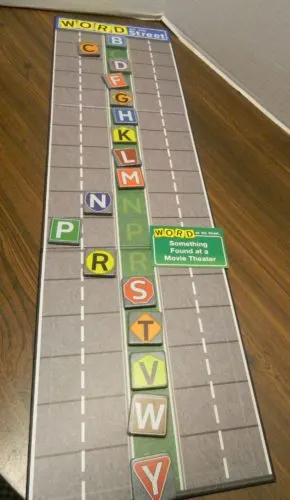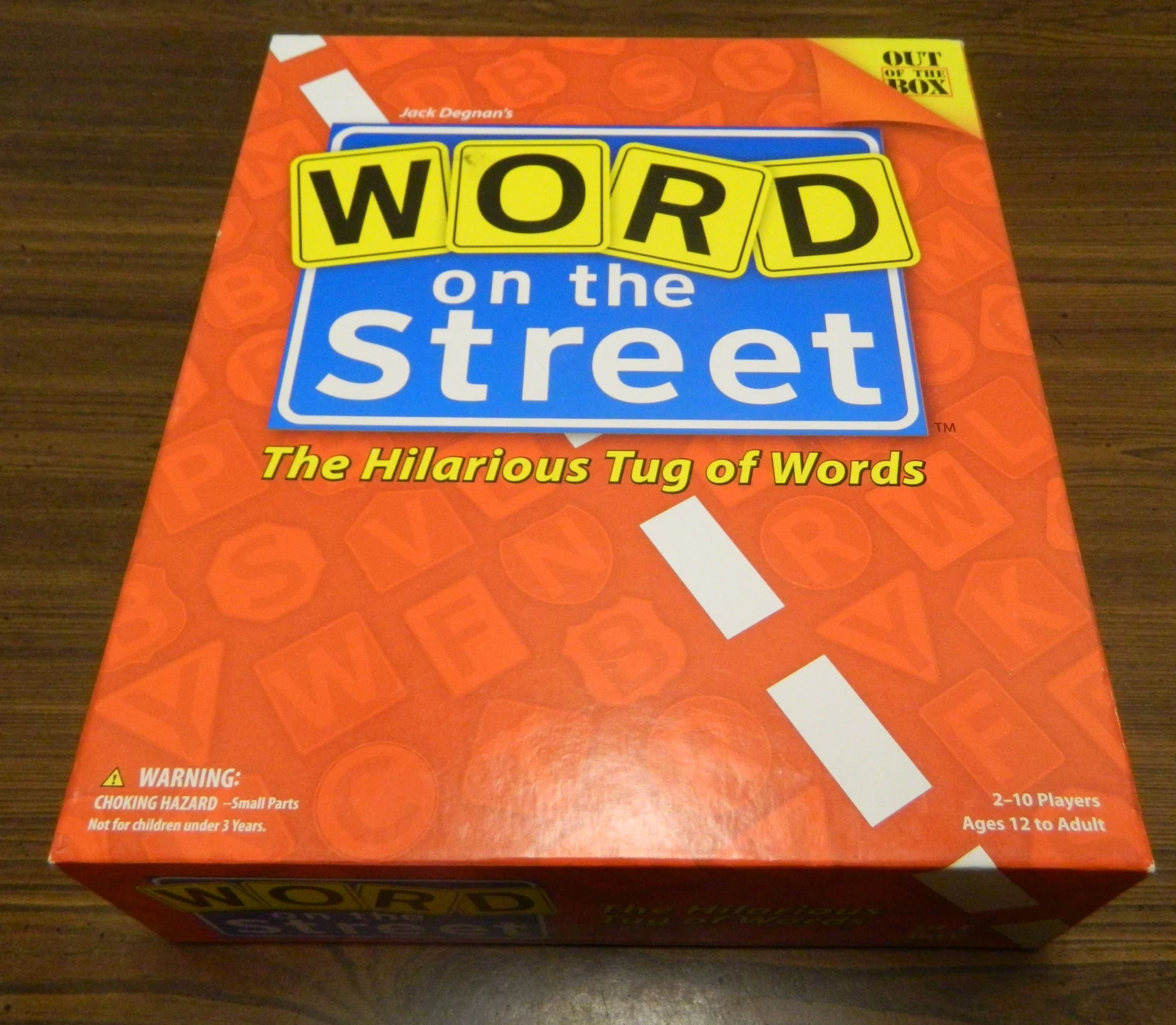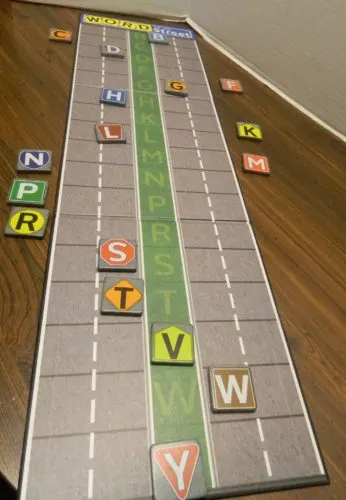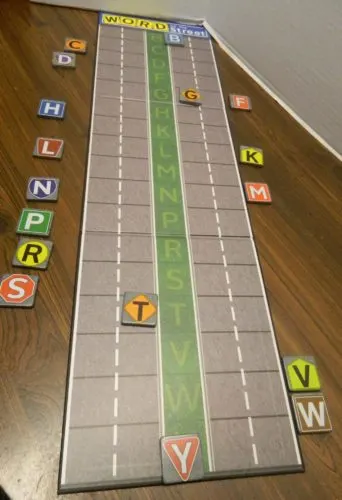How to Play
Setup
Divide into two teams. Place all of the letter tiles on their corresponding spots in the middle of the gameboard. Decide whether you are going to use the green (easier) or blue (harder) side of the cards. Determine which team will start.
Playing the Game
Teams take turns as the team “on the street”. The next card is flipped over to the side both teams agreed to (green or blue) and the timer is flipped over. Players from the “on the street” team need to brainstorm words that fit the category from the card that was flipped over. The team must agree on one word before the timer runs out. When coming up with words players need to consider the letter tiles out on the board. When a team chooses their word they get to move all of the letter tiles that are part of the word they chose one space towards their side of the board. If a letter appears in the word more than once, that letter moves as many spaces as it appears in chosen word. The team must choose their word and move all of the tiles before the timer runs out though.

This team has to come up with a word that fits the category “something found at a movie theater”. This team has chosen the word “popcorn”. The letters c, n, and r appear in the word once so they are moved one space towards the current team’s side of the board. Since the letter p is in the word twice it moves two spaces towards the team’s side of the board.
If a tile is ever moved off one side of the board, that team has captured that letter tile. The other team can still use that letter in words they come up with but they cannot move captured letter tiles back onto the gameboard.
When deciding on words to use the following rules must be followed:
- The word chosen must be a single word.
- Any English word is allowed even capitalized words.
- Singular and plural forms of words can be used if they make since for the category.
- Past and present tenses are allowed if they work for the category.
- Hyphenated words are only allowed when they are part of a name.
If the other team does not think the word the other team chose for the round is spelled correctly or doesn’t fit the category, they can challenge the word. If there is a challenge of whether the word fits the category a vote is held to decide if it should count. If the vote ends up in a tie, all of the tiles are returned to their previous spots, but the team that was “on the street” gets to redo their turn. If the word is determined to be incorrect, all tiles moved have to be moved back and the current team does not get a new turn. If the word is determined to be correct, the challenging team loses their next turn.
End of Game
The game ends when one team has captured eight of the letter tiles. This team wins the game.
Review
One of the more popular board game genres is the word game. Ever since Scrabble became a huge success many board game designers and publishers have tried to make their own word games. These games generally borrow pretty heavily from games like Scrabble where you score more points for creating longer words and using less common letters. As a whole I have mixed feelings about the word game genre. I enjoy word games. The problem with the genre though in my opinion is that very few games in the genre do anything new so once you have played a word game it feels like you have played all of them. I am always on the lookout for interesting word games though which brings me to Word on the Street created by Out of the Box.
Word on the Street is one of the most original word games that I have played in quite some time. Word on the Street feels like a mix of Scrabble, Scattergories, and tug of war. The basic mechanic in the game is spelling/coming up with words like every other word game. Word on the Street adds a Scattergories mechanic where you have to come up with a word that fits the category of the card that was just drawn. Finally there is the tug of war element as players are fighting back and forth for letter tiles trying to capture them for themselves. This unique blend of mechanics makes Word on the Street one of the better word games I have played in quite some time.
One of the most interesting things about Word on the Street is that it has quite a bit of strategy for a word game. Games like Scrabble have some strategy as far as where to play tiles but the game mostly relies on a large vocabulary so you can maximize the use of your tiles. Word on the Street is interesting because you have to make strategic decisions over what letters you try to use in words. You can either play offensively mostly trying to capture tiles for yourself or you can play defensively by keeping tiles from your opponents. Unless you are significantly better than your opponents though you really can’t just play offensively or defensively since you can’t win with either strategy by itself. You need to do a good job deciding when to try to capture tiles and when to prevent the other team from capturing tiles. Sometimes the category card you are dealt will make that decision for you but you usually have more of a decision than you would think.
Being a word game, having a strong vocabulary/spelling skills is obviously helpful. I don’t think it is as important as it is in other games though. This is because to do well in Word on the Street you don’t always need to use the longest words that you can. Sometimes a three to four letter word can be just as valuable as a seven or eight letter word if it uses the right letters. A team that has a stronger vocabulary will clearly have an advantage in the game but I don’t know if they will always win like they would in most word games. A team that is good at controlling the tiles on the board could end up winning the game even if the other team uses longer words.
The key to this is the fact that words that use multiple instances of a letter are very valuable in Words on the Street. The key to capturing tiles is using words that have repeat letters. Unless a team is really unlucky with category cards or just ignore a particular letter, it is pretty easy to prevent a team from capturing a tile. Teams will end up letting the other team capture some tiles (unless they are that much better than the other team), but when it gets towards the end of the game it becomes really hard to make any progress without using words that use duplicate letters. Using words with three or more of the same letter can be used to steal a letter out from another team.
Word on the Street has a recommended age of 12+. While young children won’t be able to play the game, I think the accessibility of the game will come down to a player’s vocabulary/spelling skills. The game itself is pretty easy and children should have no problem understanding how to play the game. I think children under 12 with good vocabulary skills shouldn’t have a problem playing the game before age 12.
Word on the Street is a fun game but does kind of have an end game problem. When you get to only around five or so tiles remaining, the game tends to grind to a halt. This occurs since the players start narrowing their focus to the letters that remain on the board. This means that players will spend all of their time on these letters which means that they can usually come up with a word that uses at least one of the letters. On top of all of this, the usual letters (V, W, Y) are likely to be some of the letters remaining. This means that your words are rarely going to use a letter twice since how many words use two v’s, w’s, or y’s?
So at this point in the game, it truly becomes a game of tug of war. Unfortunately it is not a good game of tug of war. Usually one player moves one or two of the tiles one space towards their side of the board. Then the other team reverses that by coming up with their own word that uses the same tiles. The only way to really capture tiles at this point is to have one team get category cards that don’t work for a letter while the other team gets category cards that work for a particular letter. I think it might take longer to get the last one or two tiles than it takes to get the rest of the tiles required to win the game. Word on the Street is a fun game that screeches to a halt at the end as one team limps to the finish line.
I think this problem can be fixed pretty easily though. I think the only thing you have to do is reduce the number of tiles you need to win the game. Reducing the tiles needed to win to six or even seven tiles will make a world of a difference. This should fix the problem because there will be more tiles still on the board at the end of the game so there will be more possibilities for the players. Players won’t all be going for the same tiles so the tiles shouldn’t keep moving back and forth as often.
Other than the problems with the end game stalling, the only other problem that I have with the game is that all of the category cards were not created equally. First I don’t know if I agree with the game’s opinion on which categories are easier. I found the blue side on a lot of the cards to be easier than the green side. Otherwise I just found some cards to be considerably better than others. This means that card draw luck does have an impact on the game. The problem with some of the cards is that they only give you a limited set of answers while others give you a ton of words that you can use. This means that teams that get the better cards have a lot more flexibility and are more likely to move more tiles on their turn. The game has quite a bit of skill which makes it kind of a shame that luck plays a role in determining the winner of the game.
Like a lot of Out of the Box’s games, Word on the Street should be commended on the quality of it’s components. While the gameboard is a little on the bland side, it serves its’ purpose. The letter tiles are quite thick and are nice. While it is just a cosmetic thing, I like when publishers include quality components with their games. Another thing that I really like about the components is the pure quantity of cards included. The game includes 216 cards which means you can play 432 rounds without one repeat category. I honestly think you will never run out of cards to use for the game since by the time you play through all 432 categories you will forget what word was used for the card the first time you played it.
Final Verdict
I have to say that I was pleasantly surprised by Word on the Street. It is one of the better word games that I have played recently. I was worried that the game would play like every other word game but it actually plays quite a bit differently. There is a lot more strategy to the game than a lot of word games. Also while a strong vocabulary will help, it is possible for a team to win the game against a team with a better vocabulary utilizing a good strategy of choosing which tiles to target. Word on the Street is not perfect though. The end game drags on for too long and luck comes into play based on card draw luck
If you hate word games, Word on the Street is probably not going to change your opinion. It has more strategy than most word games but the basic mechanics are the same as every other word game. If you like word games I would seriously consider Word on the Street. Even if you already own a lot of word games I would consider Word on the Street since it brings something new to the genre.
If you would like to purchase Word on the Street, you can purchase it on Amazon here.



